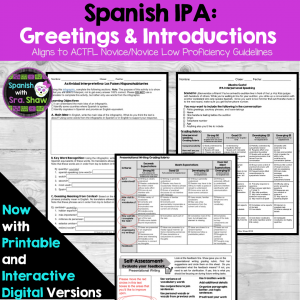Did you know that teaching Spanish introductory conversation and greetings vocabulary can actually be fun? While it’s one of the most useful topics we can teach our students because, let’s be honest, it’s the first thing they’ll need to know when interacting with anyone, most Spanish teachers I know DREAD teaching it. Today I’m excited to share activities to make greetings vocabulary engaging for both you and your students.

1. ¡Música, claro!
There’s no better way to help vocabulary stick than with music. I found this super teeny bopper (and also authentic) music video last year and my students really enjoyed it. Without any introduction, I asked them to 1) count how many times they heard, “Cómo te llamas” and 2) figure out what the point of the video was. Note: The video is middle school appropriate, but there’s a little kissing scene at 2:50, so heads up an that. You may want to freeze your screen or just have kids listen to the song instead of watch it.
2. Comprehensible input with SUPER engaging authentic resources
You can teach greetings vocabulary all you want, but nothing will help those concepts stick or seem relevant like showing real-life examples of people actually introducing themselves to others. While it can be time-consuming to find just the right video clips, try looking for Spanish gameshows or competitions shows like La Voz, Master Chef Junior México/Colombia/Argentina, and interviews.
My all-time favorite resource features 6 high-interest, authentic videos and a confidence-building activity for students to practice their interpretive listening skills. My students love getting to watch performances and interviews from a Spanish teen singing competition. Save yourself tons of time with this activity that is ready to go for any level, either as new information or a review for upper levels.
- 3 versions (PDF, Self-grading Google Form, & Interactive Google Slides version, which can be assigned on any LMS (Google Classroom, Schoology, Canva, etc.)
- Designed using the ACTFL interpretive task activity comprehension guide
- Motivate students by using familiar words while scaffolding in new vocabulary and building inference skills
- Proficiency assessment rubric or self-evaluation rubric
Check out this video to see what I mean:
3. Video Clips
Students love watching YouTube anyway and there are some really cute, snippets with people introducing themselves. You could have students share the Spanish vocabulary they hear, make a quick cloze activity, or even type up a bunch of greetings and have students circle what they hear. There are a ton of videos all over YouTube, but here are a few of my favorites:
This cute clip from Up! is really repetitive AKA your students will get to hear “Hola, me llamo… Yo soy…” several times.
The popular adage “Hi, I’m Olaf and I like warm hugs” comes to life in this Frozen clip. Plus, you’ll hear Olaf and Ana introduce themselves in different ways and you’ll hear Ana introduce Sven, which is a rare opportunity to see that 3rd person introduction.
4. Citas Rápidas Interpersonal Conversation Practice
Practice makes perfect, right? Often, when I show my students introductory conversation vocabulary, they whine that they “already know this stuff.” That’s about when I ask them if they can actually have the conversation and the answer is very frequently no, or at least not without a greetings vocabulary list in front of them.
Enter citas rápidas (speed-dating). You can make a joke that students don’t actually date, but have a set amount of time to have a conversation. You can structure it as much as you want, but I always project a slide letting students know what I’m looking for in their conversations (Greeting, say your name, ask how the other person is doing, say it’s nice to meet them, say good-bye, etc.).
Ver esta publicación en Instagram
The most important thing to do is to set up your desks in rows facing one another, decide how your students will rotate through their spots, designate a set amount of time, and let them know your expectations. You can read more about some different interpersonal speaking strategies and speed-dating in this blog post.
5. Interpersonal Writing Practice
Another great method to have students practice interpersonal skills is to have them do their favorite activity: texting. During every unit, I give students choice about how they can demonstrate their mastery of skills. Some students choose to text their friends and submit a screen recording video of the conversation while others use Texting Story App (available on Google or Android) to create cool videos of texts like the example you see below. Another good option is ifaketext.com, which creates an image of a text conversation that students can create like this one.
Looking for more interpersonal practices ideas? Grab this fun speaking freebie activity here; it’s perfect for virtual, hybrid, or face-to-face.
6. Authentic assessments (so engaging they don’t feel like assessments)
Before I have students take the assessment, I like to have students track their growth and monitor what skills they’ve mastered and which ones they’re still working on. Check out this Yo Puedo Can-Do Statement Progress Tracker, which is wonderful to communicate what students will actually need to be able to do from the start of the unit and monitor their growth for each learning objective.
The best way to get your students speaking and build confidence is to show them all that they can do with the perfect assessment. In this case, I use my best-selling IPA (integrated performance assessment) that features 3-tiered activities: interpretive listening and reading, interpersonal speaking, and presentational speaking or writing.
Students and teachers rave about this IPA, in particular, because it features an interpretive listening and reading activity that shows how much students learned with this resource. It features the MOST ADORABLE authentic resource on the planet. I’ve never seen students actually smile while they take an assessment, but I promise your students will. Here’s a video overview:
7. Keep it simple!
The beginning of the year is stressful enough. Keep it simple for you and for your students with this ready-made introductory unit for greetings and introductions.
You’ll save tons of time (and $$$) with this discounted GROWING bundle. It has everything you need to start your students off on the right food to spice up your greetings unit with authentic resources, real-life opportunities to use the vocabulary. Plus, it has ACTFL-aligned practice and assessment activities with tons of comprehensible input! Save your sanity and grab it here.
I hope that this post gave you some inspiration so that teaching greetings and introductions is fun and engaging! I know we’re all hoping that the 2021-2022 school year is full of normalcy, growth, and peace.
Con abrazos,














No Comments